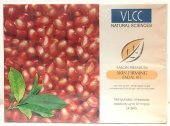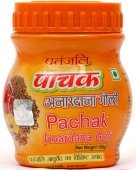Pomegranate: 4 definitions
Introduction:
Pomegranate means something in Hinduism, Sanskrit, biology. If you want to know the exact meaning, history, etymology or English translation of this term then check out the descriptions on this page. Add your comment or reference to a book if you want to contribute to this summary article.
In Hinduism
Shilpashastra (iconography)
Source: Shodhganga: Elements of Art and Architecture in the Trtiyakhanda of the Visnudharmottarapurana (shilpa)The Pomegranate colour is sometimes associated with Nāsatya (i.e., the twin god Aśvins), whose iconography is described in the Viṣṇudharmottarapurāṇa, an ancient Sanskrit text which (being encyclopedic in nature) deals with a variety of cultural topics such as arts, architecture, music, grammar and astronomy.—According to the Viṣṇudharmottarapurāṇa, the body complexion of the statue of Aśvins is like the colour of lotus leaf which is very dark green in colour. But According to the Śilparatna, the complexion of Nāsatyas should be of the colour of the pomegranate. Thus it is clear that the Viṣṇudharmottarapurāṇa offers a great field of knowledge regarding the nuances of Indian art of Image making [e.g., the pomegranate colour] during 10th–11th century A.D.

Shilpashastra (शिल्पशास्त्र, śilpaśāstra) represents the ancient Indian science (shastra) of creative arts (shilpa) such as sculpture, iconography and painting. Closely related to Vastushastra (architecture), they often share the same literature.
Ayurveda (science of life)
Agriculture (Krishi) and Vrikshayurveda (study of Plant life)
Source: Asian Agri-History: Drumavichitrikaranam—The Ancient Approach to Plant MutagenesisPomegranate (identified with Punica granatum) was used in the process of organic plant mutagenesis by ancient Indian agriculturists, which presents a safe technology and methodology regarding organic agriculture, according to treatises (such as the Vrikshayurveda). One such technology was to produce flowers and fruits on other species of plants and trees: The term drumavichitrikaranam (“plant mutagenesis”) obtains its true meaning in the literal sense through this objective. Some of them are described in the Upavanavinoda of Śārṅgadhara: such as to grow Punica granatum (pomegranate) fruits on Musa paradisiaca (plantain tree).
Source: Shodhganga: Drumavichitrikarnam—Plant mutagenesis in ancient IndiaPomegranate (fruit) (in Sanskrit: Dāḍimī-phala) was commonly produced using various bio-organical recipes for plant mutagenesis, according to the Vṛkṣāyurveda by Sūrapāla (1000 CE): an encyclopedic work dealing with the study of trees and the principles of ancient Indian agriculture.—Accordingly, “Musa paradisiaca trees create wonder by producing pomegranate fruits (dāḍimī-phala) if fed by water mixed with the urine of a hog and Alangium salviifolium. (A word is unintelligible). Ricinus communis tree produced from a seed cultured by the marrow of a boar, treated further by the process in the previous verse, produces Momordica charantia fruits”.

Āyurveda (आयुर्वेद, ayurveda) is a branch of Indian science dealing with medicine, herbalism, taxology, anatomy, surgery, alchemy and related topics. Traditional practice of Āyurveda in ancient India dates back to at least the first millenium BC. Literature is commonly written in Sanskrit using various poetic metres.
Biology (plants and animals)
Source: Google Books: CRC World Dictionary (Regional names)Pomegranate in English is the name of a plant defined with Punica granatum in various botanical sources. This page contains potential references in Ayurveda, modern medicine, and other folk traditions or local practices.
Example references for further research on medicinal uses or toxicity (see latin names for full list):
· Annals of the New York Academy of Sciences (1936)
· New Botanist (1981)
· FBI (1879)
· Species Plantarum (1753)
· Journal of Ethnopharmacology (2009)
· Ann. Cat. Vasc. Pl. W. Pakistan & Kash. (1972)
If you are looking for specific details regarding Pomegranate, for example side effects, pregnancy safety, extract dosage, diet and recipes, health benefits, chemical composition, have a look at these references.

This sections includes definitions from the five kingdoms of living things: Animals, Plants, Fungi, Protists and Monera. It will include both the official binomial nomenclature (scientific names usually in Latin) as well as regional spellings and variants.
See also (Relevant definitions)
Starts with: Pomegranate juice.
Full-text (+278): Dadima, Dalima, Kalkaphala, Satphala, Shukavallabha, Dadimba, Pindira, Shukadana, Parvaruh, Kucaphala, Svadvamla, Manivija, Mukhavallabha, Kuttima, Madhuvija, Raktavija, Dalimba, Raktavarga, Pancamla, Suphala.
Relevant text
Search found 71 books and stories containing Pomegranate; (plurals include: Pomegranates). You can also click to the full overview containing English textual excerpts. Below are direct links for the most relevant articles:
Parables of Rama (by Swami Rama Tirtha)
Story 58 - Law of love < [Chapter IX - Love]
Rasa Jala Nidhi, vol 5: Treatment of various afflictions (by Bhudeb Mookerjee)
Chapter 14 - Symptoms and treatment of Arochaka (aversion to food)
Chapter 16 - Symptoms and treatment of Trishna (thirst)
Chapter 1 - Symptoms and treatment of Raktapitta (Hemoptysis)
Garga Samhita (English) (by Danavir Goswami)
Verse 2.17.13 < [Chapter 17 - The Meeting of Śrī Rādhā-Kṛṣṇa]
Verse 4.19.124 < [Chapter 19 - A Thousand Names of Srī Yamunā]
Verses 2.21.1-4 < [Chapter 21 - The Rāsa-dance Pastime]
Rasa Jala Nidhi, vol 4: Iatrochemistry (by Bhudeb Mookerjee)
Part 2 - Treatment of Piles (1): Arsha-kuthara rasa < [Chapter V - Piles]
Treatment for fever (157): Panchanana rasa < [Chapter II - Fever (jvara)]
Part 59 - Treatment for chronic diarrhea (31): Jatiphaladi rasa < [Chapter III - Jvaratisara fever with diarrhoea]
Rasa Jala Nidhi, vol 3: Metals, Gems and other substances (by Bhudeb Mookerjee)
Part 14 - Ganja (Cannabis indica) < [Chapter XXXI - Upavisha (semi-poisons)]
Part 1 - Characteristics Of Quartz (Sphatika) < [Chapter XXI - Gems (9): Sphatika (quartz)]
Part 14 - Dietary presecriptions and prohibitions when taking iron < [Chapter IV - Metals (4): Lauha (iron)]
Rasa Jala Nidhi, vol 2: Minerals (uparasa) (by Bhudeb Mookerjee)
Part 5 - Use of essence of Makshika < [Chapter II - Uparasa (2): Makshika (pyrites)]
Related products
(+12 more products available)





